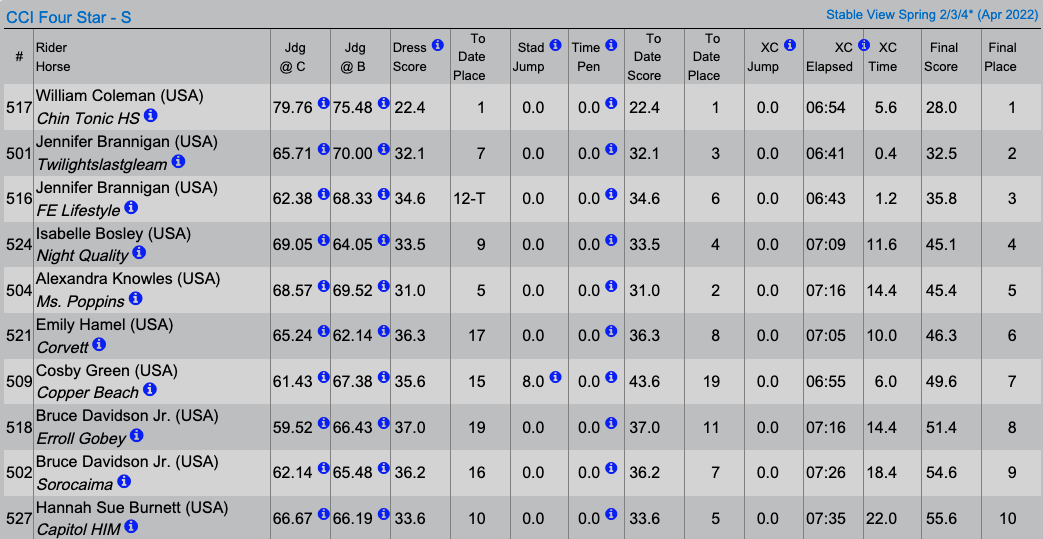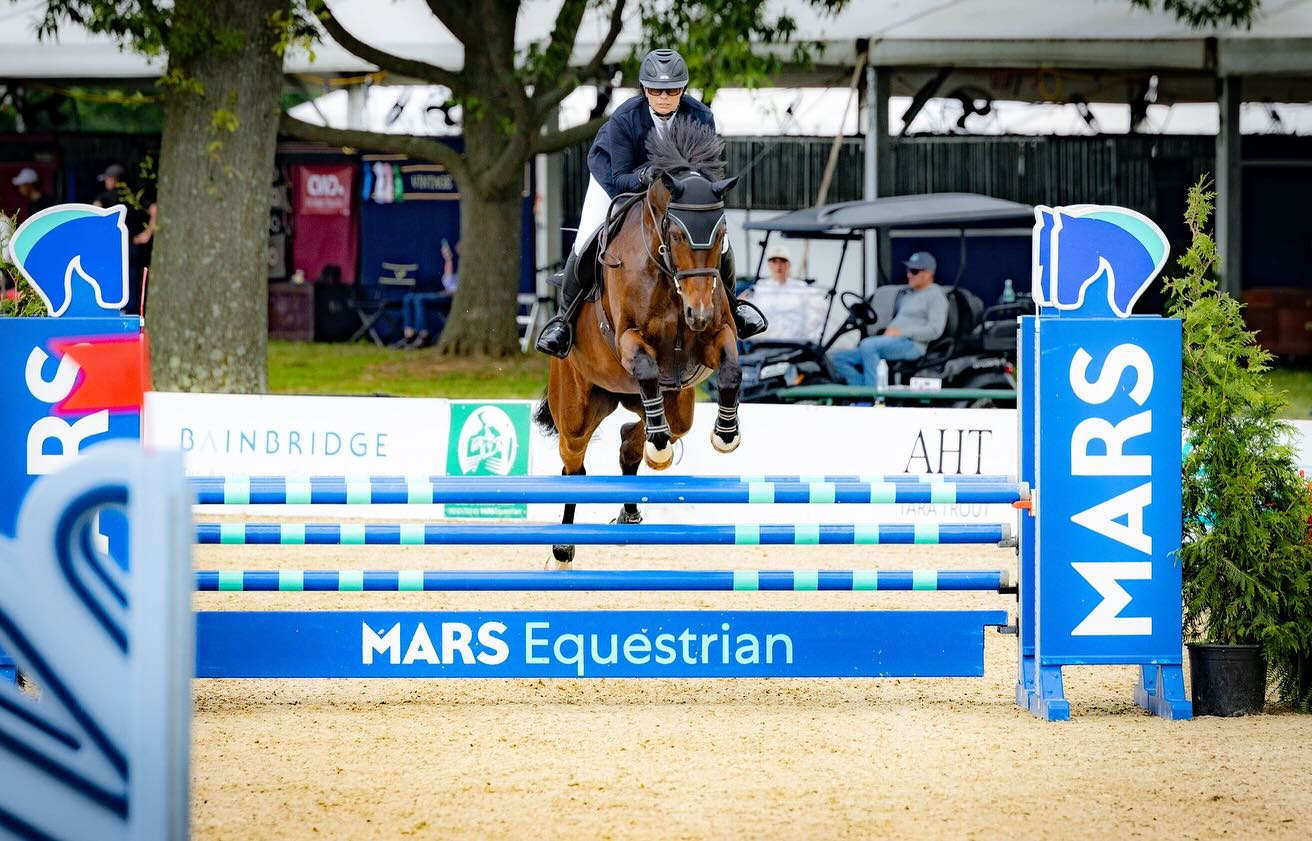
Laura Collett and London 52 pose the greatest threat to day one dressage leaders Piggy March and Brookfield Inocent, who nonetheless remained unsurpassed at the culmination of the phase. Photo by Tilly Berendt.
When Piggy March and her European silver medallist Brookfield Inocent put a slick 23.9 on the board yesterday, there were just a few horses on today’s line-up that we could feasibly eye up with a view to overtaking them – and the frontrunner, Laura Collett‘s Tokyo team gold medallist London 52, certainly gave it a jolly good go. But though he certainly gave them the old razzle dazzle, as the theatre kids say, his 24.8 wasn’t quite enough to usurp them. And so, as we look towards tomorrow’s jumping phases in the CCI4*-S at Thoresby, we’re looking at a head-to-head between two of the hot favourites to go and win Badminton in a scant few weeks.
Or are we? After all, the first CCI4*-S of the season isn’t an end goal in and of itself, and because Thoresby is effectively a brand new event – it hosted the British Six- and Seven-Year-Old classes and associated CCI2*-L and CCI3*-L ordinarily held at Osberton in 2020, but the launch of its Spring Carnival has been put on hold throughout the pandemic – there’s a strong sense that many horses will be run conservatively. It’s not just because it’s a new event and, as such, an unknown quantity to riders, either – it’s also quite an intense track, certainly when compared to the former fixture at Belton House that it replaces. There, we saw a lot of open space and galloping fences to serve as a pipe-opener at the beginning of the year; here, we’re looking at a smaller event site, and that means that the track is tighter as a matter of necessity, with plenty of technical questions.
Of course, this isn’t necessarily a bad thing. There are certainly plenty of pros to a run-and-jump four-star track at this point of the year: for many horses, a pipe-opener takes the edge off and gets them going again after a long winter of training, while riders are able to glean feedback on fitness levels and weak points ahead of their major spring run. But a track that demands focus and accuracy knocks a different kind of rust off, and while it may mean that many riders opt to ride more deliberately (and thus slowly) to avoid risking a frustrating run-out, it does allow them to make sure the power steering is all working as it ought to. Exposing a weakness in the training now might feel frustrating – but with just over a month to go before Badminton, it does allow some modicum of time to do something about it.
But before we do too deep a dive into tomorrow’s challenge, let’s take about our top two, who are both horses with plenty of experience over tight, twisty tracks: Brookfield Inocent was second at Pau in 2020, the year that London 52 won it. Both horses were debutants at the level, too, and each has since gone on to claim a gold medal on a championship team. And though we’re used to seeing London 52’s work rewarded with low-20s scores, both look on superb form after a winter out of the spotlight.
“He’s been a bit frisky in his OI runs,” laughs Laura, “but luckily he does know that when it’s a big arena, he has to behave properly! I think he just gets a bit offended by a smaller ring. But he came out really professionally today, and the main thing is that he was with me and rideable – sometimes, he looks better than he feels, but today he felt really nice.”
This is a feeling that Laura hopes to further refine out on course, where the challenges come in droves and even her excellent gelding — who’s become something of a flag-seeking missile across the country — will need to pay attention to find his way through sans penalties.
“I think everything’s going to come up thick and fast. You’re not just jumping a combination — you’re doing a turn back to the next thing and it’s all coming up fast, so you just have to be on it from the beginning. It’s going to test their — and my — reactions, really.”
Laura also sits in provisional eighth place with Aachen runner-up Dacapo, who posted a 26.6, and 61st with the former Alex Bragg ride Hester, who scored a 35.6.

Harry Meade gives Little Fire an excellent ride under the watchful eye of William Fox-Pitt, for whom he’s deputising this week. Photo by Tilly Berendt.
Harry Meade is a very busy boy indeed this week, with three horses of his own in this class – plus the last-minute addition of two bonus catch-rides, one of which partnered him to podium position at the tail end of the day. Little Fire is one of William Fox-Pitt‘s two intended rides at Badminton – the other is Oratorio II, who Harry rode yesterday to a rather spicy 35.4 – but after a tumble at Cirencester last weekend in a Novice class, William has been sidelined with a mandatory 21-day competition ban, which is delivered to any rider rendered unconscious in a fall. Harry deputised for William two days later, riding both horses around the Open Intermediate, and now will give the geldings their prep run here while William works on reaching five-star fitness independently.
Though Oratorio, who William has fondly described as an occasional ‘double handful’, tested the boundaries in some moments of yesterday’s test, Little Fire stepped up as the model pupil today with his regular rider casting a watchful eye from the sidelines. As a result, he was rewarded with a very promising 25.4, which puts him in third in this hot field of of 99.
Several withdrawals have shifted the landscape of the leaderboard even before the jumping phases begin. Izzy Taylor and Monkeying Around sat fourth at the end of the day on 25.4 but have since pulled out; so, too, has Oliver Townend, who was eleventh and equal fifteenth with Swallow Springs and Ballaghmor Class, respectively, at the end of the phase. This is par for the course for Oliver, who tends to use the first four-star of the season as test prep and runs his horses at Burnham Market instead, and we’ve seen Izzy follow suit previously, too.

Ros Canter and Allstar B deliver a very sweet test that’s surprisingly undermarked. Photo by Tilly Berendt.
Izzy’s withdrawal allowed reigning World Champions Ros Canter and Allstar B to step into equal tenth place, which they share with Kentucky-bound Pippa Funnell and Maybach on a score of 27.5.
“Alby’s on really great form,” says Ros, who credits a change of routine over the winter with helping him to get back to his best. This comes after an uncharacteristic end to their 2021 season, in which they had issues on course at the European Championships at Avenches, a track that the big-striding horse struggled to find the rhythm of. Prior to that, the pair had travelled to Tokyo as reserves for the British Olympic team – a trip that cut out much of the productive running time of the summer season.
“Last year was a very long year for him, and obviously it didn’t go quite to plan in lots of ways, so I was very mindful that I didn’t want to come out with a horse that wasn’t up for the job this year,” she explains. “So he predominantly hacks nowadays; if he does do any schooling, he’ll school out on a hack, rather than doing lots of arena work – and he definitely feels happy.”
For Ros, as for so many of our five-star-bound competitors, this weekend is a question of tactics: riders have to know their horses well enough to make the call on whether they’ll benefit more from trying to catch the time or trying to refine the communication basics, which can often pick up some rust over the course of a long winter. In Alby’s case, the emphasis is set to be far more on the latter than on a fast, competitive run.
“Twisty and turny’s not Alby’s ideal, but I also wouldn’t necessarily ever try to make this a winning run pre-Badminton, so a bit of twisting and turning might just help his manners a bit, and then he’ll get to run at Badminton,” she says. “I think it’s a really interesting track; it’s lovely and open at the start, and then it’s twisty for quite a long time with a lot of questions. It’s definitely more than an OI run!”

Matt Flynn and Wizzerd put their early-season prep to the test in their first major pre-Badminton outing. Photo by Tilly Berendt.
We were particularly excited to catch up with Matt Flynn, who swapped 90-degree Ocala heat for April snow flurries in pursuit of his Badminton goals. After a fruitful European trip last autumn, which saw them contest Boekelo CCI4*-L and then on to Italy for Montelibretti’s CCI4*-S and Pratoni’s CCI4*-L, Matt opted to leave Wizzerd to enjoy his winter holidays at Arville, the Belgian base of Lara de Liedekerke-Meier and Kai Steffen Meier. In December, they trained for a month from there, and in mid-January, the pair relocated to Maizey Manor in Wiltshire – a long-standing hub for American eventers on tour – and began their preparations in earnest.
“It’s just ten minutes from Tim and Jonelle Price, who have been kind to enough to lend me a lot of guidance through this trip so far,” says Matt, who also has a seven-year-old and a four-year-old in the UK with him.
Today, he and Wizzerd delivered a sweet test – with one exuberant moment in the first flying change — for a respectable 34.1, which puts them into 42nd ahead of tomorrow’s jumping phases and well and truly kicks their season off.
“Wizzerd’s been great — and he’s excited to be out,” says Matt, who admits that the British season — which starts later than the Florida one, mostly because we were buried under mud and ice here until approximately yesterday, feels like a very short one in the run-up to a five-star.
“I was anxious to get going, to be honest, because it felt like everyone at home was up and going, and it’s a little bit of a different calendar – but it feels nice to have had the time and the training on the horses I have here. And this — well, it’s a beautiful setting, and it seems like it’s going to be a great run.”
Tomorrow takes us neatly into the culmination of Thoresby’s CCI4*-S, in which the prestigious Grantham Cup will be awarded – a prize that, since its inception at Belton in 2006, has been awarded to some of the top British-based combinations, including Sam Griffiths and Happy Times, Oliver Townend and Ashdale Cruise, Vittoria Panizzon and Borough Pennyz, and Ruth Edge and Two Thyme. Showjumping for the remaining 99 combinations will begin at 10:00 a.m. BST (5.00 a.m. EST), while cross-country will begin at 12.22 BST (7.22 a.m.). You can check out the cross-country course in its entirety here – and although we’re sorry to say there’s no live-stream available this year, we’ll be back tomorrow evening to bring you a full report and analysis, plus our views on what the day’s action means for our Kentucky- and Badminton-bound entrants.
Stay safe, kick on, and Go Eventing!

The top ten going into tomorrow’s jumping phases in the Thoresby CCI4*-S.
Thoresby Spring Eventing Carnival: [Website] [Live Scoring] [EN’s Coverage] [EN’s Twitter] [EN’s Instagram]




















































































































